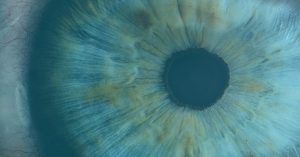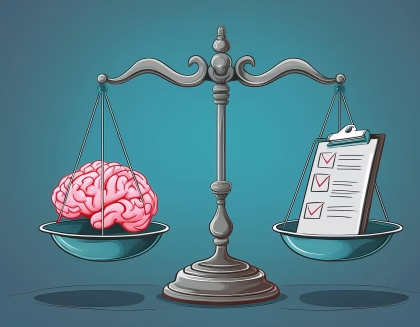Eye tracking is a technology that monitors and records eye movements to understand visual attention and behavior. It employs infrared sensors or cameras to track eye positions and movements. By analyzing the data, researchers, and developers gain insights into user behavior, usability, and cognitive processes for various applications, such as user experience testing and medical diagnosis.
The Definition of Eye Tracking
Eye tracking refers to the process of measuring where we look, also known as our point of gaze. These measurements are carried out by an eye tracker, that records the position of the eyes and the movements they make.
Near-infrared light is directed toward the center of the eyes (pupil), causing detectable reflections in both the pupil and the cornea (the outer-most optical element of the eye). These reflections – the vector between the cornea and the pupil – are tracked by an infrared camera. This is the optical tracking of corneal reflections, known as pupil center corneal reflection (PCCR).
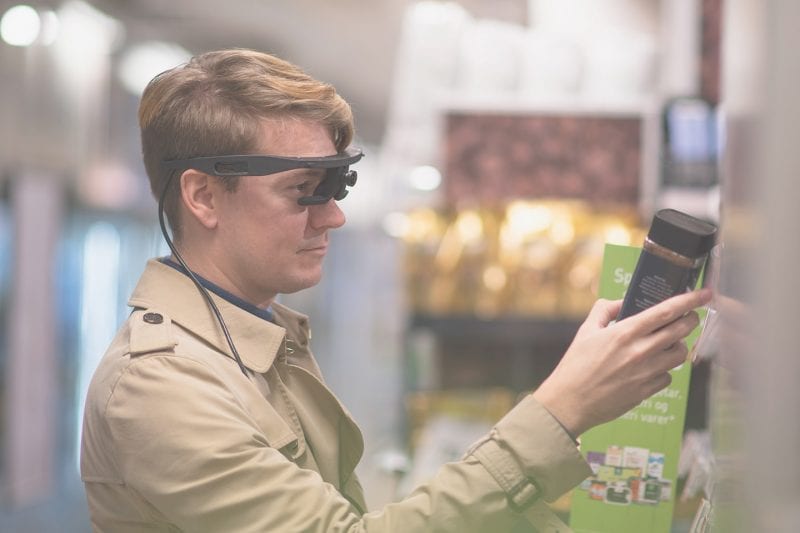
An infrared light source (and thus detection method) is necessary as the accuracy of gaze direction measurement is dependent on a clear demarcation (and detection) of the pupil as well as the detection of corneal reflection. Normal light sources (with ordinary cameras) aren’t able to provide as much contrast, meaning that an appropriate amount of accuracy is much harder to achieve without infrared light.
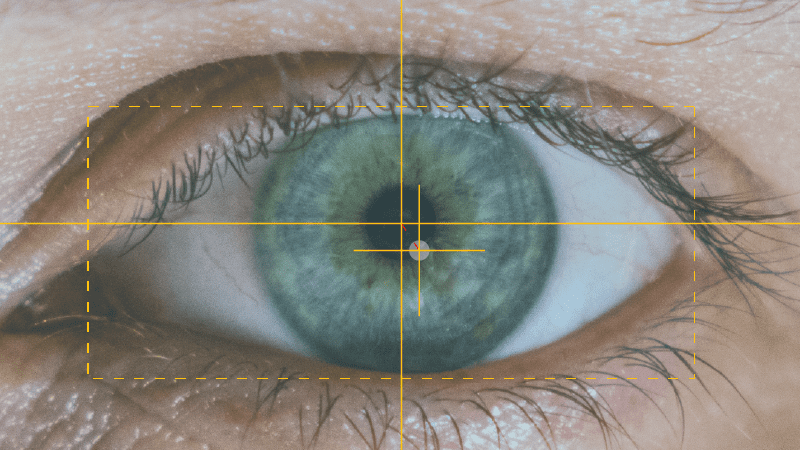
Light from the visible spectrum is likely to generate uncontrolled specular reflection, while infrared light allows for a precise differentiation between the pupil and the iris – while the light directly enters the pupil, it just “bounces off” the iris. Additionally, as infrared light is not visible to humans it doesn’t cause any distraction while the eyes are being tracked.
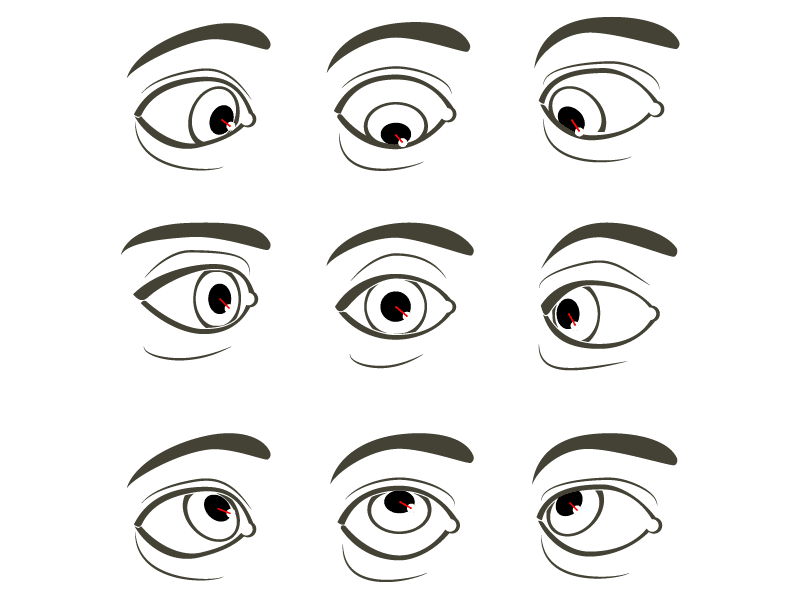
Types of Eye Trackers
While there are many different eye trackers, there are two principal types: screen-based and glasses. They are used across variety of fields and research areas, but how they are used and the data they provide as a result can differ.
Let’s have a look at the key features of each:
Screen-Based eye Trackers
- Screen-based eye trackers (which are also called desktop, stationary or remote)
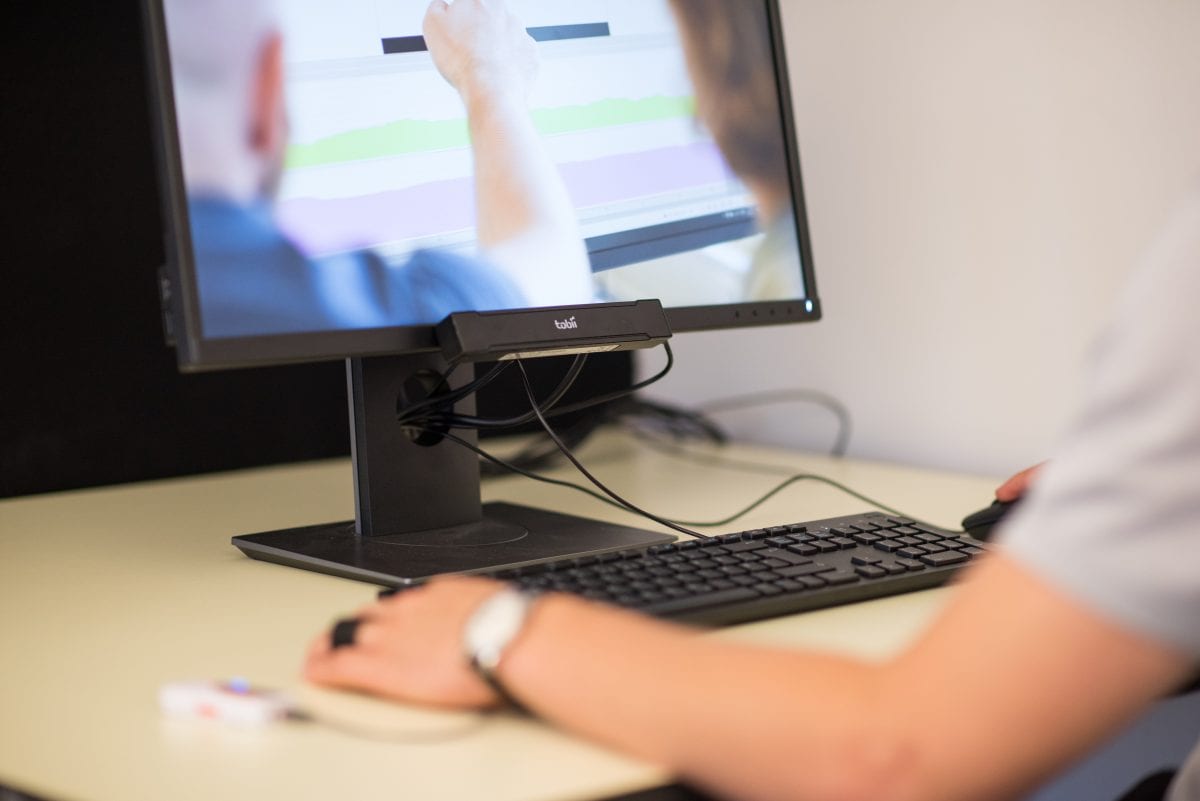
Screen-based devices require respondents to sit in front of a monitor and interact with screen-based content. Although these devices track the eyes only within certain limits (the so-called headbox), the freedom of movement is still sufficiently large for respondents to be relatively unrestricted (at least in terms of a normal range of movement while watching screen-based stimuli).
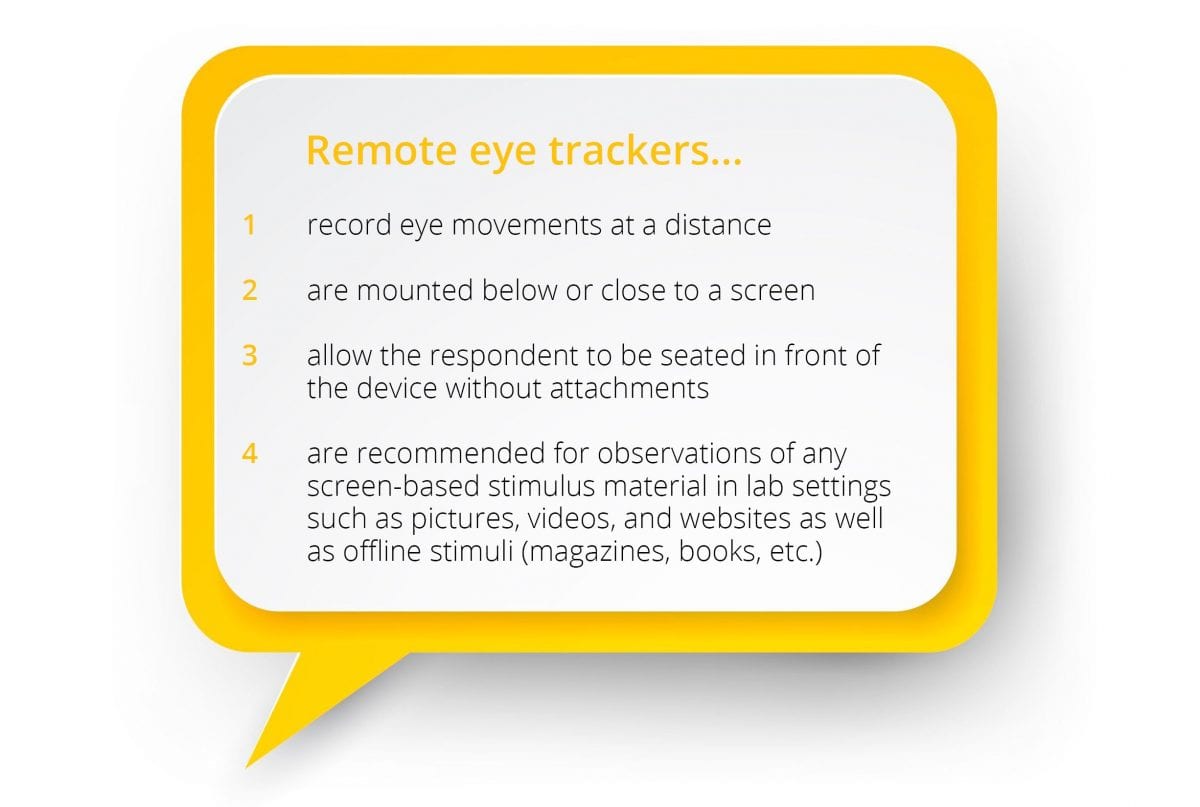
Eye Tracking Glasses
- Eye tracking glasses (which are also known under the term head-mounted)
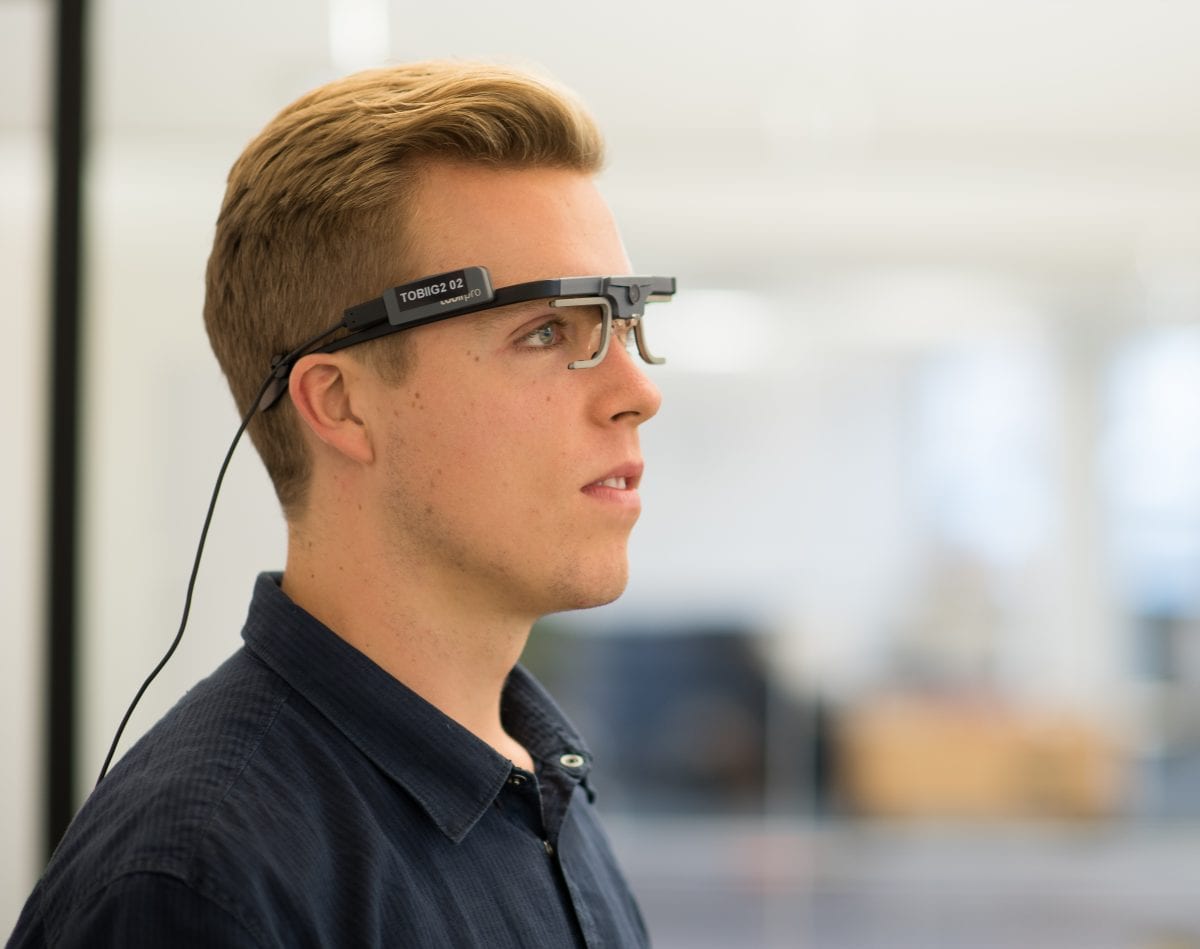
As the name implies, mobile devices are fitted near the eyes (usually mounted onto eyeglass frames) and allow respondents to move freely. Clearly, this is a plus if your study design requires performing tasks in a natural environment. On the downside, the glasses could potentially shift during the recording if there is a large amount of movement (such as within sports).
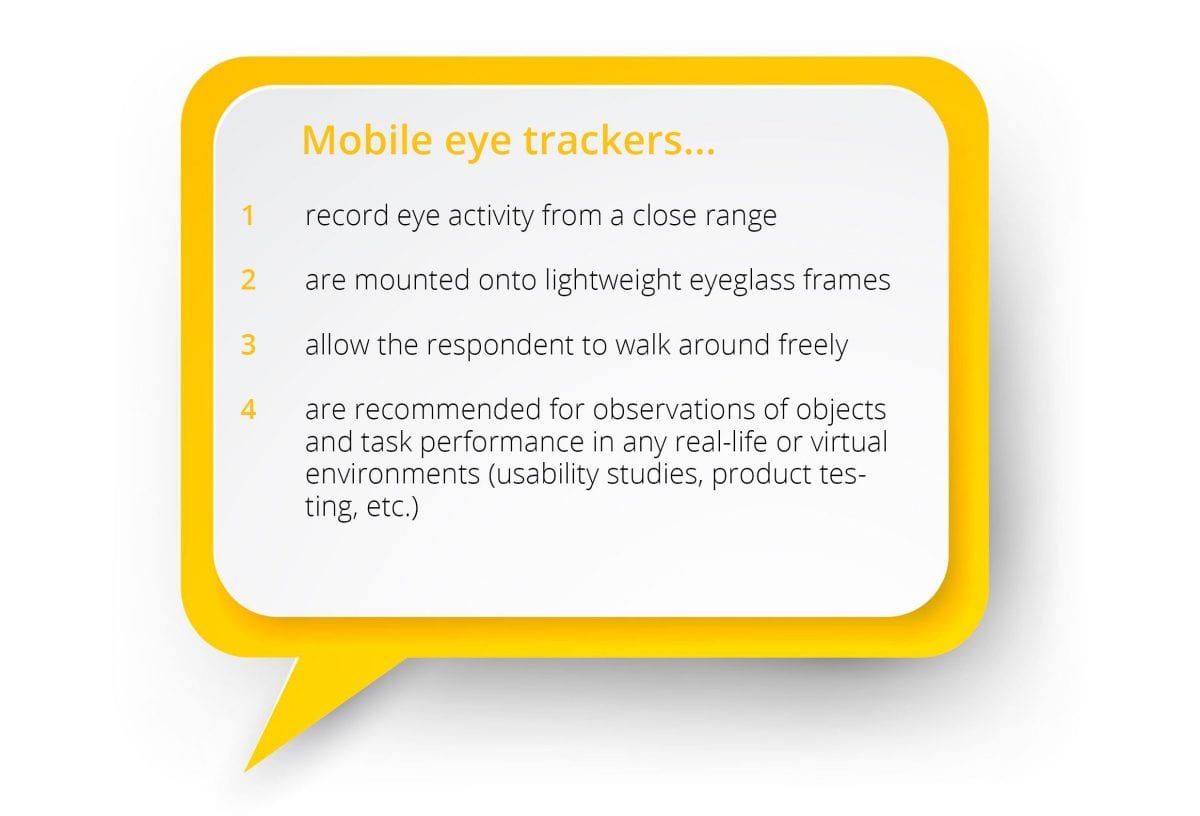
When to Choose Screen-Based Eye Tracking or Eye Tracking Glasses
Eye tracking devices are continuously being produced and launched onto the market. Amidst all the manufacturer specifications, it can be quite hard to keep an overview and evaluate which eye tracker is right for your research endeavor.
Which recording device should you go for? Start with the obvious:
- Will your respondents be seated in front of a computer during the session? Go for a screen-based eye tracker.
- Do your respondents need to move freely in a natural setting or virtual reality? Choose a head-mounted system that allows for head and body mobility.
Check out: How to choose the best eye tracking glasses for Your research?
Once you have clarified which kind of tracking system suits your study design, it’s time to read the fine-print. Before your purchase, think about these key questions that can make or break your research:
Key questions to ask for eye tracking research
Eye tracking camera
- Which camera is integrated into the eye tracker? Avoid eye trackers that integrate ordinary low-resolution webcams and use no infrared light.
Even though they appear to be a good bargain and the ideal solution for smaller budget, the lack of a controlled light source along with a rather weak camera performance will render your data quality effectively useless.
Our advice: When it comes to eye trackers it‘s absolutely worth spending a bit extra money if you‘re aiming for high-quality results (which you should).
Integrated vs. standalone eye trackers
- Is the eye tracking hardware integrated into the monitor frame? Standalone eye trackers are more flexible, and often cheaper, but integrated hardware can have particularly high specs.
Sampling rate
- How many times per second does the eye tracker measure the eye position? While the typical value ranges anywhere between 30 and 60 Hz, research-grade equipment often samples between the range of 120-1000 Hz (this of course depends on the research question being asked).
Recapture rate
- How fast does the eye tracker detect the eye position after the eyes have been out of sight for a moment (e.g. during blinking)?
Measurement precision:
- How precise (measured in degrees) does the eye tracker measure gaze direction? While less expensive hardware starts around 1.0 degree, high-end trackers measure down to 0.1 degree (or lower).
How Does iMotions Eye Tracking Software Work
Motions’ eye tracking software follows a series of steps to capture and analyze eye movement data, providing insights into visual attention and cognitive processes. Here’s a breakdown of these steps:
Integration with Eye Tracking Hardware
iMotions software is compatible with a variety of eye tracking hardware. The first step is to connect the software to these devices, which typically use infrared cameras to capture detailed images of the user’s eyes.
Calibration
Before starting a session, the software requires calibration with the user. This involves the user looking at different points on a screen so the software can accurately track the gaze in relation to the screen coordinates.
Data Collection
Once calibrated, the software starts collecting data. As the user looks at different parts of the screen, the eye tracker records various metrics, such as point of gaze, fixation duration, and pupil size.
Real-Time Gaze Visualization
The software provides real-time visualization of gaze patterns. This can include heatmaps, showing areas of high visual attention, or gaze plots, which trace the path of the user’s gaze over time.
Analysis of Eye Movements
The software analyzes the collected data to derive insights. This can include metrics like fixation count (how often the gaze pauses), saccade length (how far the gaze jumps), and areas of interest (specific parts of the screen where the user focused).
User Behavior Insights
By analyzing these metrics, iMotions software helps in understanding user behavior. For instance, long fixations might indicate difficulty in processing information, while frequent saccades could suggest searching behavior.
Integration with Other Biometric Data
iMotions also allows for the integration of eye tracking data with other biometric information like EEG, facial expression analysis, and GSR (Galvanic Skin Response), providing a comprehensive understanding of the user’s cognitive and emotional state.
Reporting and Exporting Data
After the session, the software enables the export of collected data and generates reports. These reports can be customized to include specific metrics and visualizations relevant to the study.
Application in Research and User Testing
The software is widely used in academic research, marketing studies, usability testing, and other fields where understanding visual attention and cognitive processing is essential.
What Can Eye Tracking Be Used For?
Eye tracking is used across a range of different research fields, and for various different applications within the commercial realm too.
Obtaining detailed information about where an individual or group of people look is useful in a range of contexts, from psychological research, to medical diagnosis, neuromarketing applications and beyond.
Psychology
Understanding when and how people look is essential for understanding how attention is distributed. Eye tracking is widely used within psychological tests like the IAT (implicit association test), Stroop Test, and the Iowa Gambling Task, as well as within gaze contingency paradigms.
Healthcare
Tracking an individual’s gaze can also be important in medical settings. Studies have shown the potential predictive power of eye tracking in diagnosing autism, as well as other neurological disorders. Future uses may see the application of eye tracking data in providing optimal patient care in healthcare settings.
Neuromarketing
Following gaze patterns while people shop has been a growing topic within neuromarketing for many years now. Being able to see what people attend to or ignore can be crucial for implementing optimal packaging design, store layout, and point-of-sale displays.
Eye tracking data can also deliver valuable insights into the gaze patterns of your website visitors – how long does it take them to find a specific product on your site, which kind of visual information do they ignore (but are supposed to respond to)? Where do your website visitors look? What do they look at and how much time do they spend looking at it?
Check out: How Eye Tracking Technology Is Changing The World [5 Examples]
Eye Tracking Glasses
The Complete Pocket Guide
- 35 pages of comprehensive eye tracking material
- Technical overview of hardware
- Learn how to take your research to the next level
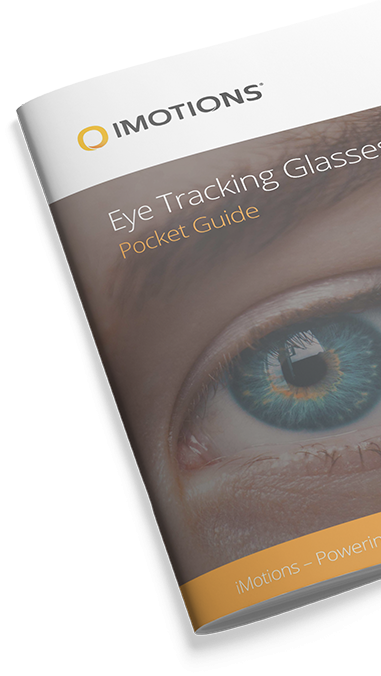
Human Behaviour Insights vs Limitations
What Eye Tracking Can Reveal about Human Behaviour
Eye tracking can reveal:
- What people look at on a screen or in the real world
- When attention is placed on certain visual elements
- How long each fixation lasts for
- The order in which visual elements are fixated upon
- If an individual’s gaze returns to a visual element that was looked at before
What Eye Tracking Can’t Reveal
Eye tracking however can’t alone reveal:
- Why an individual looked at a certain visual element
- How they felt when looking at a visual scene
With the evolution of computer technology, eye tracking has become a non-intrusive, affordable, and easy-to-use tool in human behavior research that allows the measurement of visual attention as it objectively monitors where, when, and what people look at.
Given the ease of application and measurement, it’s no wonder that eye tracking technology finds increasing popularity among a rapidly growing variety of academic and commercial disciplines, well above and beyond the topics mentioned above.
Eye Tracking Metrics and Terms
Eye tracking makes it possible to quantify visual attention as it objectively monitors where, when, and what people look at. There are a variety of different metrics used in eye tracking research, but some of the more common ones are given an overview below.
Gaze Points
- Gaze points: Definitely the most prominent metrics in eye tracking literature. Gaze points constitute the basic unit of measure – one gaze point equals one raw sample captured by the eye tracker.
Fixations
- Fixations: If a gaze point is maintained for a duration, it becomes a fixation, a period in which our eyes are locked towards a specific object.
Areas of interest (AOI)
- Areas of interest (AOI): To concentrate the analysis on specific regions on the stimulus, an AOI can be defined – this is a region which can then be compared against other AOIs if desired.
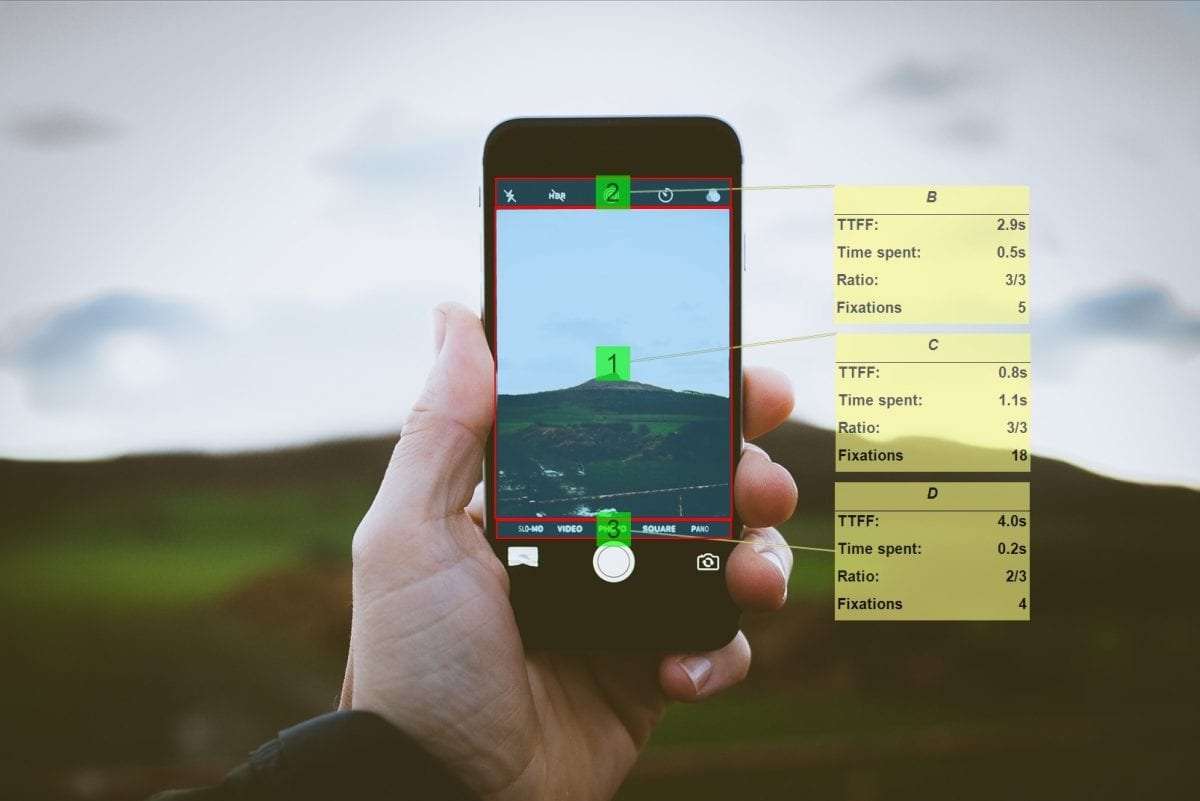
Heatmaps
- Heatmaps: A heatmap is a visualization of fixation positions over time as an overlay on a specific stimulus. These can be aggregated to compare across groups, or compared across participants.
Fixation sequences
- Fixation sequences: By detailing the order and direction in which the fixations occur, it’s possible to see what caught a participant’s attention first, and the way in which the stimulus was viewed.
Time To First Fixation (TTFF)
- Time To First Fixation (TTFF): Similar to above, the time between stimulus onset and the viewing of a defined region provides information about when a particular AOI is first seen. This can be informative for assessing what is attended to (and what isn’t) in a visual scene.
While these eye tracking metrics are commonly used to track visual attention, it’s also possible to use pupillometry (a measure of pupil size) as a proxy for physiological arousal, going beyond just attention. Other metrics that can potentially provide further information about the participant include the distance to the screen, ocular vergence, and blinks.
Eye Tracking
The Complete Pocket Guide
- 32 pages of comprehensive eye tracking material
- Valuable eye tracking research insights (with examples)
- Learn how to take your research to the next level
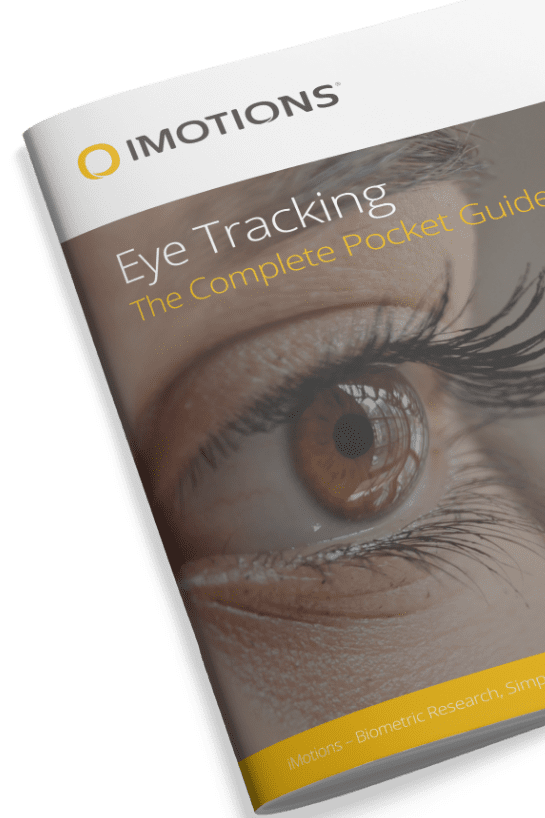
This article was originally published in January 2016. Last updated September 2023.
Checkout: 20 books to help you unlock eye tracking technology
More articles about eye tracking
- Infant Research – The Complete Pocket Guide
- Automated Areas of Interest (AutoAOI) Best Practices
- Virtual Reality (VR) Research – The Complete Pocket Guide
- Best Alternatives to SMI Eye Trackers
- Introducing iMotions’ New Automated AOI Module
- Smart Eye Aurora 60Hz Eye Tracker White Paper: Real-World Performance, Real Results
- Unlocking the Potential of VR Eye Trackers: How They Work and Their Applications
- Exploring Mobile Eye Trackers: How Eye Tracking Glasses Work and Their Applications
- Understanding Screen-Based Eye Trackers: How They Work and Their Applications
- Can you use HTC VIVE Pro Eye for eye tracking research?
- The Importance of Research Design: A Comprehensive Guide
- Top 5 Publications of 2023
- Understanding Cognitive Workload: What Is It and How Does It Affect Us?
- The Best Neuroscience Software
- Neuromarketing Software Solution




